Compton Herbarium
Jamesbrittenia breviflora (Schltr.) Hilliard
Family:
Common names: There are no recorded common names for this species; other Jamesbrittenia species are sometimes known as verfblommetjies (little paint-flowers).
Plant Attributes:
Plant Type:
SA Distribution:
Soil type:
Flowering season:
PH:
Flower colour:
Aspect:
Gardening skill:
Special Features:
Horticultural zones
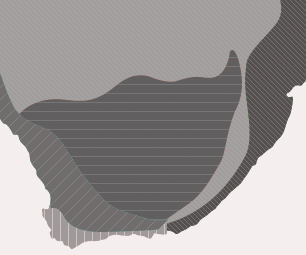
Iridaceae
Family:
Common names: Iris
Plant Attributes:
Plant Type:
SA Distribution:
Soil type:
Flowering season:
PH:
Flower colour:
Aspect:
Gardening skill:
Special Features:
Horticultural zones

Hyacinthaceae
Family:
Common names: hyacinth family
Plant Attributes:
Plant Type:
SA Distribution:
Soil type:
Flowering season:
PH:
Flower colour:
Aspect:
Gardening skill:
Special Features:
Horticultural zones

Hessea Herb.
Family:
Common names: umbrella lilies; sambreeltjies (Afr.)
Species
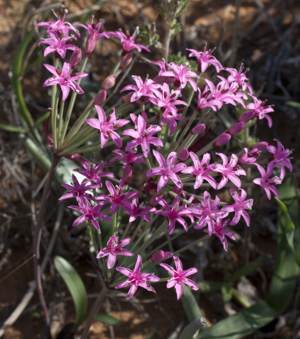
Hessea breviflora Herb.—Plants up to 200 mm high; bulb extended into a stout neck. Leaves 2(3), often emerging at flowering, 4–16 mm wide, shiny green, flushed with red basally, surrounded by a prominent brownish red sheath.
Flowers 10–55, star-shaped, 7–15 mm long, pale to deep pink, sometimes scented, stamens slightly shorter to longer than the tepals, spreading, fused into a 1.0–4.5 mm long filament tube. April–May.
Sandy pockets between rocks on lower slopes. Namaqualand, Olifants River valley to Hopefield.
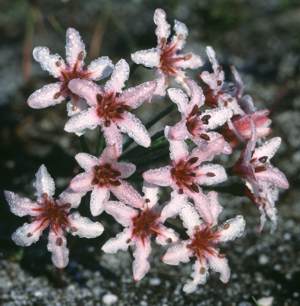
Hessea cinnamomea (L'Hér.) Durand & Schinz—Plants up to 150 mm high; bulb extended into a slender neck. Leaves (1)2, dry or emerging at flowering, 1.0–2.5 mm wide, dark shiny green.
Flowers 5–27, star-shaped, spreading to one side, widely funnel-shaped, 10–14 mm long, glistening white to pink with a wine-red centre, scented of spice, tepals crisped, stamens shorter than the tepals, filament tube up to 0.5 mm long. May–June, after fire.
Peaty soils. Lowlands of the south-western Cape.
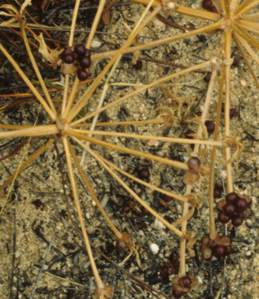
Hessea monticola Snijman—Plants up to 250 mm high; bulb with a long neck. Leaves usually 2, dry at flowering, 1.5–3.0 mm wide.
Flowers usually 10–30, star-shaped, white to pink with deep pink stripes leading down the throat, unpleasantly scented, tepals 10–25 mm long, with crisped edges, stamens shorter than the tepals, the filaments fused into a 1 mm long tube. March–May, usually after fire.
Rocky slopes or elevated, seasonally wet valleys. Piketberg and Cederberg to Houhoek Mountains.
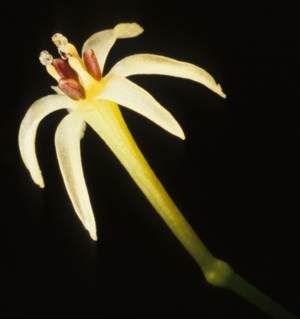
Hessea stenosiphon (Snijman) D. & U.Müll.-Doblies—Plants up to 200 mm high; bulb extended into a slender neck. Leaves 2 or rarely 3, dry at flowering, 1.0–3.5 mm wide.
Flowers 3–14, with a long, slender, greenish to reddish tube, 8–12 mm long, tepals narrow and recurved, 6–8 mm long, pale lemon, inner filaments appearing jointed, longer than outer filaments. April–May.
Seasonally moist rock crevices and soil pockets on granite domes. Kamiesberg Mountains.
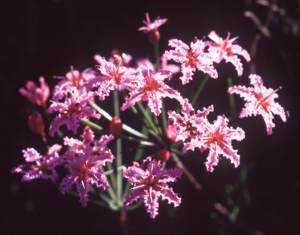
Hessea undosa Snijman—Plants up to 230 mm high; bulb with a slender neck. Leaves 2, dry at flowering, 1–2 mm wide.
Flowers 7–20, star-shaped, glistening pale to deep pink, with a reddish centre, scentless, tepals 6.5–8.0 mm long, with crisped edges, as long as the spreading stamens, the filaments fused into a basal tube up to 1 mm long. June–July.
Seasonally waterlogged sandstone rock pockets. Mountains near Vanrhynsdorp.
Plant Attributes:
Plant Type:
SA Distribution:
Soil type:
Flowering season:
PH:
Flower colour:
Aspect:
Gardening skill:
Special Features:
Horticultural zones

Haemanthus crispus Snijman
Family:
Common names: crispy-leaved paintbrush lily
Plant Attributes:
Plant Type:
SA Distribution:
Soil type:
Flowering season:
PH:
Flower colour:
Aspect:
Gardening skill:
Special Features:
Horticultural zones

Gethyllis L.
Family:
Common names: kukumakranka (Eng.); koekoemakranka, bramakranka (Afr.)
Species
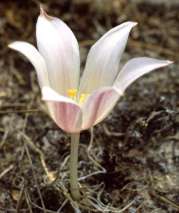
G. afra L. Plants 100-140 mm high. Leaves 12-30, linear, erect to spreading, spiralled, usually channelled, occasionally with simple, soft spreading hairs on one or both surfaces or the margin. Flower cup-shaped, white with pink reverse, tepals 20-35 mm long, anthers 9-18 in clusters of 6, style straight, as long as the stamens, stigma small. Berry club-shaped, fleshy, yellow to red. Flowering time: December to January. Lowland flats in fynbos from Clanwilliam to Heidelberg.
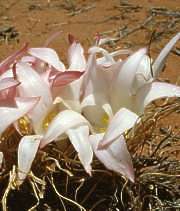
G. ciliaris (Thunb.) Thunb. Plants often forming clumps, 150-300 mm high. Leaves 15-25, narrowly strap-shaped, spiralled, firm, shiny green, the margins fringed with rigid, upturned hairs, the basal sheath 1, mostly subterranean, pale, spotted with maroon when exposed. Flower cup-shaped, ivory to deep pink, waxy, tepals 30-70 mm long, anthers 15-31 in 6 clusters, style straight and stout, stigma narrowly trifid. Berry club-shaped, yellow. Flowering time: December to February. Coastal forelands in deep sand, southern Namaqualand, Nardouwsberg to Cape Peninsula.
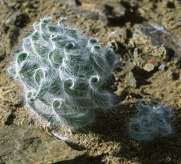
G. villosa (Thunb.) Thunb. Plants 30-150 mm high, sometimes clumped. Leaves 4-12, narrow and tapering to each end, spreading, loosely spiralled towards the apex, more or less covered with soft, white, T-shaped hairs, the margin and apex often with dense, firm, compound hairs. Flower white or pink, tepals 20-40 mm long, anthers 6, style longer than the stamens, curved sideways, stigma broadly 3-lobed. Berry slender, cylindrical, membranous, white with red seeds. Flowering time: October to December. In sand or clay on flats or south-facing slopes, Namaqualand to Mossel Bay and western Karoo.
Plant Attributes:
Plant Type:
SA Distribution:
Soil type:
Flowering season:
PH:
Flower colour:
Aspect:
Gardening skill:
Special Features:
Horticultural zones

Gazania splendidissima Mucina, Magee & Boatwr.
Family:
Common names: None
Plant Attributes:
Plant Type:
SA Distribution:
Soil type:
Flowering season:
PH:
Flower colour:
Aspect:
Gardening skill:
Special Features:
Horticultural zones

Eulophia speciosa (R.Br. ex Lindl.) Bolus
Family:
Common names:
Plant Attributes:
Plant Type:
SA Distribution:
Soil type:
Flowering season:
PH:
Flower colour:
Aspect:
Gardening skill:
Special Features:
Horticultural zones

Eriocephalus L.
Family:
Common names: wild rosemary (Eng.); kapokbos, wilderoosmaryn (Afr.)
Species
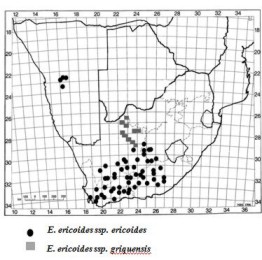
Eriocephalus ericoides is the most widely distributed species of Eriocephalus and is subdivided into two subspecies, E. ericoides subsp. ericoides and E. ericoides subsp. griquensis. The former thrives in the stony clay and sandy flats from Namibia to the Free State and the Northern, Western and Eastern Cape. The latter is restricted to the Northern Cape, stretching from the Orange/Gariep River to near the Botswana border.
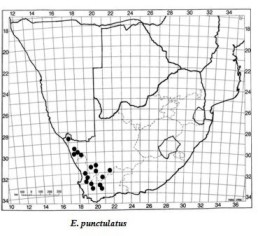
E. punctulatus is restricted to the winter- rainfall region (Greater Cape Floristic Region) and occurs from Namaqualand south to the Roggeveld and Witteberg mMountains (Mu ller et al., 2001)

Eriocephalus eximius is restricted to high mountainous areas along the Southern Great Escarpment.
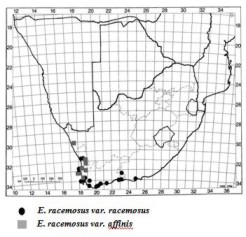
E. racemosus is found on sandy soil along the coast extending from Hondeklip Bay to Melklbosstrand and Port Elizabeth to Lambert's Bay. There are 2 varieties; E.racemosus var. affinis extends from Hondeklip Bay to Melkbosstrand and E .racemosus var. racemosus is found from Port Elizabeth to Lambert's Bay.
Plant Attributes:
Plant Type:
SA Distribution:
Soil type:
Flowering season:
PH:
Flower colour:
Aspect:
Gardening skill:
Special Features:
Horticultural zones

Dicerothamnus rhinocerotis (L.f.) Koekemoer
Family:
Common names: rhinoceros bush, rhenoster bush (Eng.); renosterbos, rhenosterbos (Afr.)
Plant Attributes:
Plant Type:
SA Distribution:
Soil type:
Flowering season:
PH:
Flower colour:
Aspect:
Gardening skill:
Special Features:
Horticultural zones






Rate this article
Article well written and informative
Rate this plant
Is this an interesting plant?
Login to add your Comment
Back to topNot registered yet? Click here to register.